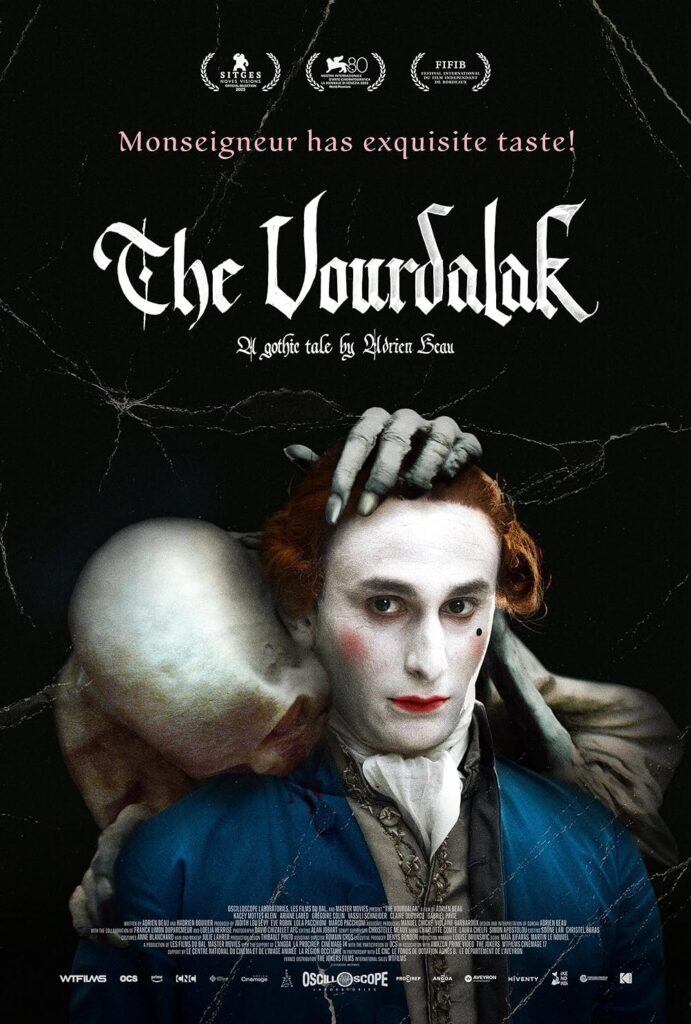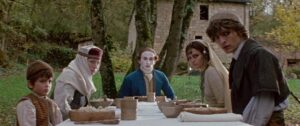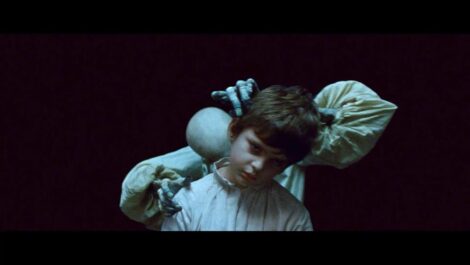Somewhere along the line, vampires became less pointedly cruel, as a rule, in their depiction. Film began to focus more on them as tortured, romantic, aristocratic figures. Vampires are just trying to figure something out. They’re going through something; could you please give the vampire some space? Adrian Beau’s THE VOURDALAK eschews the depiction of the vampire as a pained, remorseful figure just longing for the Sun. The vampire in this film is deliciously vicious, which allows for Beau to play with tools not generally seen in this kind of a genre tale.

As the film explains, “Vourdalaks” are a kind of vampire that return to their families six days after their death and specifically prey upon those that they were close to in life. This allows Beau to explore at least two tracks thematically: The first is how abused families uphold structures that allow for the abuse to continue. Jegor (Grégoire Colin) can plainly see that his father is now a cruel, twisted monster but is unwilling to let go of him, to the point of forcing his son, Piotr (Vassili Schneider), to shoot the family dog at his father’s, Gorcha (voiced by Adrian Beau), request. An alternative read is that the film is examining the cost to a family when caring for a family member with a lingering, fatal illness. We see Gorcha’s family go to great lengths to make him comfortable before his nature becomes clear. It’s not just their blood he drains, but also their love and ability to cope.
Serving as the point of view of the audience is the Marquis Jacques Antoine Saturnin d’Urfé (Kacey Mottet Klein), a foppish aristocrat who had been bound for the royal court in Paris when his companions were killed and his horse stolen. Jacques Antoine initially comes upon a shack at night during a storm. The man inside refuses to open the door, but provides him directions to the home of a man named Gorcha and tells him that Gorcha can provide a horse. We follow Jacques Antoine through the woods the following morning, where he finds a singing woman, Sdenka (Ariane Labed), who flees from him and eventually, a young man, Piotr, who leads him back to his family estate. Upon arriving, the Marquis finds that this is the home of the singing woman. Jegor tells him that he no longer has a horse to give, but will lead him to a man who can provide one. The family is awaiting the return of the patriarch, Gorcha, who left to fight the Turks. Sdenka confides that Gorcha told the family that if he returns after six days, the family should treat him as a vourdalak and not let him in. Of course, Gorcha returns after six days, as the titular vourdalak. Over the next few days, the Marquis becomes privy to the family’s secrets. Sdenka can no longer marry because she fell in love with a traveler, and so now locals assume she is “ruined.” Gorcha and Jegor prod and abuse Piotr for being effeminate.

Klein plays the Marquis with equal parts aristocratic aloofness, fear, and a restrained lustiness. When the Marquis meets Piotr in the woods for the first time, he initially mistakes him for a woman, and his first inclination is greet “her” graciously and flirting. We see that he is instantly smitten with Sdenka when he sees her sing. As the Marquis’ time at the estate wears on, he becomes more comfortable flirting and getting close with Sdenka and Piotr. One of the film’s most satisfying threads is the relationship between the Marquis and Sdenka. Until the climax, there’s a level of restraint in their interactions; his flirting growing more overt, and Sdenka tentatively accepting it, either from interest or because the Marquis is a helpful ally is dispatching the vourdalak.
An aesthetic that depicts the 18th century while having the unmistakable feel of a film that looks like it was shot in the early ’70s in Eastern Europe gives it a flavor like the work of Walerian Borowczyk or Jean Rollin. The Super 16MM photography bursts with colors that have become passé in mainstream filmmaking. The film’s methodical pacing allows us to drink in verdant jeweled forests heavy with fog, roaring fireplaces crackling with bright orange flames that excite the eye, and costumes that employ a dazzling array of color. Costuming is likely a greater delight here, because Adrian Beau worked as a house designer for Christian Dior and John Galliano. It calls to mind the kaleidoscope of color the was peak Hammer Horror in the early 1960s. The film is every bit as gorgeous as THE LEGEND OF THE 7 GOLDEN VAMPIRES or CAPTAIN CLEGG.
But if we’re invoking Hammer Horror, the next question is “What about the vampire?” Instead of choosing an actor to fill the role with a traditional performance, the vourdalak is voiced by Beau and depicted onscreen with a gruesome five-foot-tall practical puppet; Its slender frame too thin for a human actor and its withdrawn lips impractical in make-up. The puppet is able to conjure unease with its floaty movements or the sense that its voice is too powerful for its diminutive, decaying frame. Its eyes seem vacant and its mouth ever hungry, like RETURN OF THE LIVING DEAD’s half-woman. When taken with how intentionally cruel the vourdalak is, this is a thing of nightmares. Even when it is not drinking the blood of its family, it is being cruel, playing on their insecurities and fear. It’s not enough to kill what was his family. He wants them in emotional anguish before he does.
For the horror fan who feels the genre’s portrait of the vampire has become leaden and uninteresting in recent years, THE VOURDALAK is a rare pleasure. It’s remarkably different and executed confidently by a director with an unusual tool set and the skill to use it. Fashion design might not be the most common path to the director’s chair but if Tom Ford and Agnes B. have taught us anything, it’s one worth paying attention to, and that’s exactly what this colorful, gloomy nightmare deserves: your full attention.
Tags: Adrian Beau, Ariane Labed, Captain Clegg, Christian Dior, French film, Gregoire Colin, Hammer Horror, Jean Rollin, John Galliano, Kacey Mottet Klein, Return of the Living Dead, The Legend of the 7 Golden Vampires, The Vourdalak, vampires, Vassili Schneider, Walerian Borowczyk



No Comments